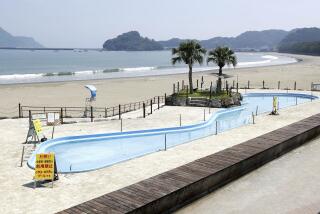Radiation hampers efforts to restore power to nuclear plant in Japan
Engineers at the Fukushima Daiichi nuclear power plant worked all day Friday attempting to connect a newly restored power line to reactors No. 1 and 2, but their task was repeatedly interrupted by the need to withdraw workers because of high radiation levels. The team said they hoped the task would be completed sometime Friday evening or in the early morning hours Saturday.
It is not clear yet, however, whether restoring power to the two damaged reactors will help with cooling. Some engineers believe the cooling pumps were irretrievably damaged by the hydrogen explosions that wracked the reactor buildings in the first four days after the March 10 magnitude 9 Tohoku quake, or by corrosion from the seawater that has been pumped into the reactor. At the very least, however, restoring power should restore many of the control functions at the reactor.
Photos: In Japan, life amid crisis
Officials of Tokyo Electric Power Co., which owns the facility 140 miles north of Tokyo, said they hoped to have power connected to reactors No. 3 and 4 by Sunday.
Reactor building No. 4 is now the source of the biggest concern at the site because it contains spent fuel rods that may have boiled dry and are releasing large amounts of radiation into the environment.
The spent-fuel pool does not have a containment vessel, so if the fuel rods heat up and start burning, the radioactive ash will be released directly into the environment.
Workers made a second series of attempts Friday to cool the fuel rods, dumping water from helicopters and using water cannons operated by Japan’s Self-Defense Forces to spray water into the pool, which sits in the upper level of the building housing reactor No. 4. The reactor itself had been shut down for maintenance before the earthquake, so it does not pose a problem.
But photographs taken by helicopters and a Global Hawk drone operated by the U.S. Air Force indicate the water is not lasting very long in the pool, suggesting that there is a major breach in the walls of the vessel holding the fuel rods, according to the U.S. Nuclear Regulatory Commission.
Recognizing the severity of the problem, Japan’s nuclear regulatory agency Friday upgraded the severity of the Fukushima disaster from four to five on the international scale of one to seven. The 1986 Chernobyl disaster, the worst nuclear disaster in history, was rated a seven.
The 1979 Three Mile Island incident, previously considered the second-worst accident in history, was also rated a five. French officials had previously called Fukushima a five and now Japanese authorities have agreed with their assessment.
But it is clear that Fukushima is a much more serious problem than Three Mile Island. Little or no radiation escaped from the Pennsylvania facility, and no one was injured there.
The Comprehensive Test Ban Treaty Organization, which monitors radiation globally, said Friday that minute amounts of radiation from Fukushima had reached the West Coast of the United States, but only at barely detectable levels that were insignificant to health.
On Sunday, meteorologists predict a heavy rainstorm for the Fukushima area, with the prevailing winds changing toward the direction of Tokyo.
More to Read
Sign up for Essential California
The most important California stories and recommendations in your inbox every morning.
You may occasionally receive promotional content from the Los Angeles Times.










